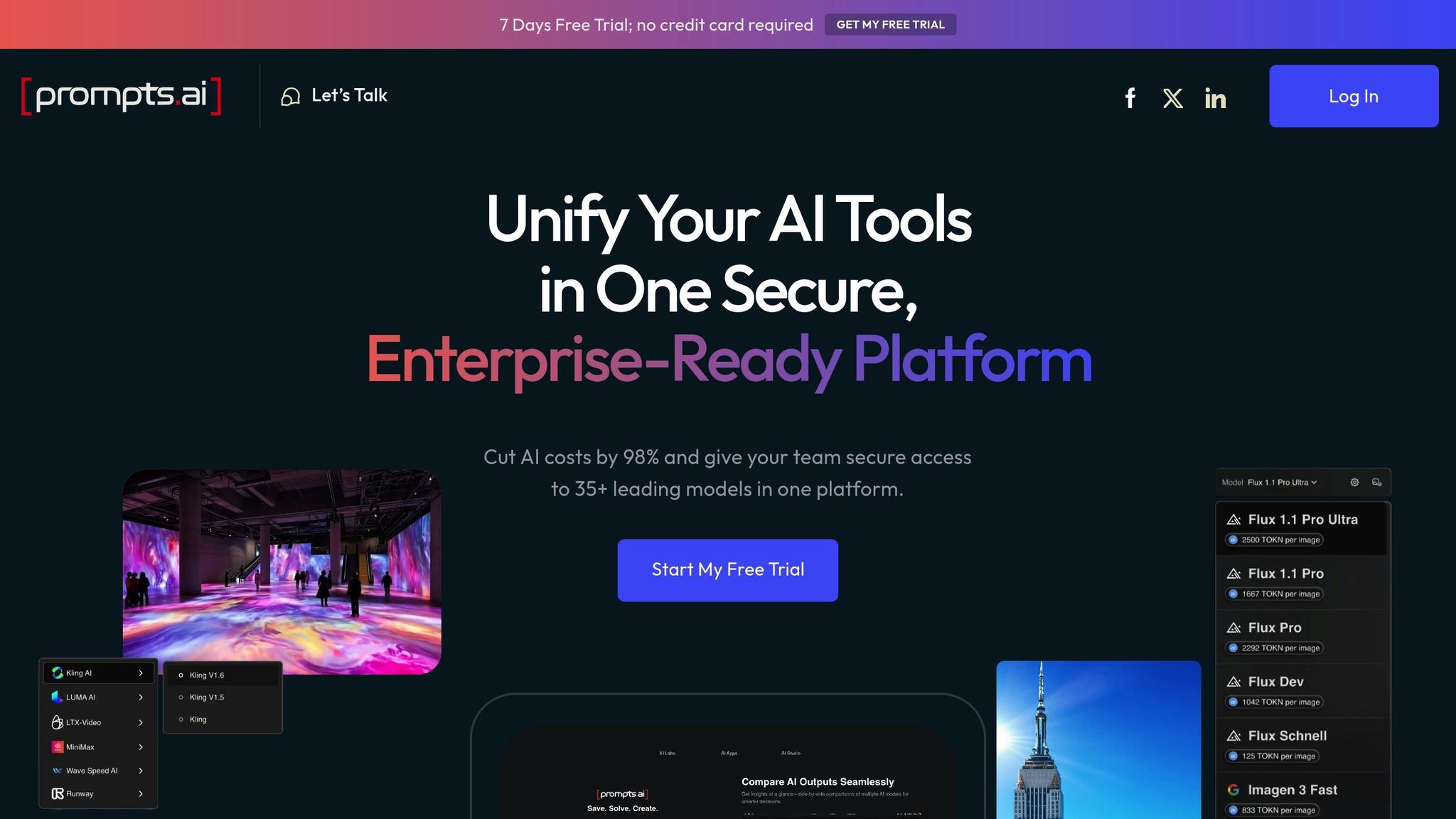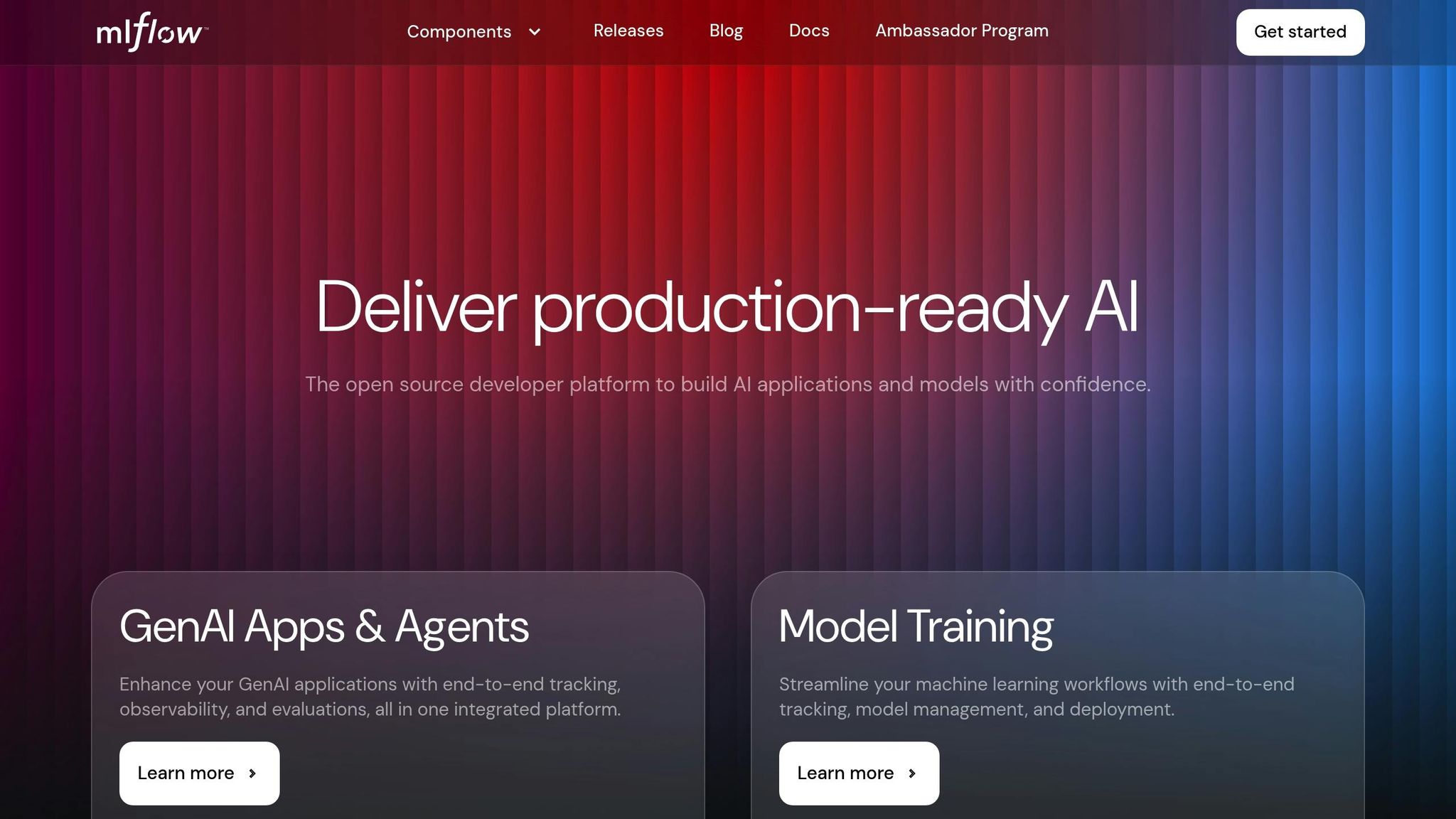
Managing AI models across an organization can be tricky. Teams often struggle with cost control, security, and performance while juggling multiple tools. To solve this, three platforms stand out:
Each tool addresses specific needs - whether you’re optimizing costs, tracking experiments, or managing deployment. Choose based on your priorities: centralized control, detailed tracking, or flexibility.
Quick Comparison:
| Feature | Prompts.ai | Weights & Biases | MLflow |
|---|---|---|---|
| Versioning | Advanced prompt tracking | Experiment-focused | Basic model registry |
| Deployment | Built-in, real-time | Limited | Flexible options |
| Cost Tracking | Token-level transparency | GPU/resource tracking | Basic logging |
| Access Control | Role-based permissions | Team-focused | Limited built-in |
| Pricing | Pay-per-use TOKN credits | Subscription-based | Open-source (hosting only) |
Pick the platform that aligns with your team’s size, goals, and technical expertise.

Prompts.ai serves as a centralized platform that integrates over 35 language models, including GPT-4, Claude, LLaMA, and Gemini, into one secure and streamlined interface. By consolidating these tools, it eliminates the inefficiencies of juggling multiple platforms, cutting AI software costs by up to 98% while giving enterprises the control they need.
The platform automatically tracks all changes made to prompt workflows, creating a detailed audit trail. This feature allows teams to review previous configurations and quickly revert to earlier versions if necessary. The result? Consistent performance and simplified troubleshooting when unexpected outcomes arise.
Prompts.ai offers precise deployment controls, letting administrators decide which models and features are accessible to specific teams. With role-based permissions, only authorized users can make changes, reducing risks and maintaining smooth operations.
Equipped with a FinOps layer, Prompts.ai provides real-time tracking of token usage across models and teams. This transparency helps organizations pinpoint exactly where their AI budget is being spent. The pay-as-you-go TOKN credit system further simplifies cost management by aligning expenses with actual usage, making budgeting predictable and controlled.
User permissions are a cornerstone of Prompts.ai. Administrators can assign custom roles to team members, specifying access to models, datasets, and features. Detailed audit logs track every interaction, ensuring compliance with regulatory standards and safeguarding sensitive data.
Prompts.ai enhances teamwork by making it easy to share prompt workflows among team members. Additionally, the Prompt Engineer Certification program empowers organizations to develop in-house AI expertise, ensuring best practices are followed consistently. This comprehensive orchestration opens the door to leveraging even more AI management tools effectively.
Weights & Biases (W&B) is designed to streamline machine learning experiment tracking and model management. It provides specialized tools tailored to data science teams handling intricate AI workflows. While Prompts.ai focuses on centralized control, W&B shines when it comes to tracking experiments in detail and analyzing resource usage. Its emphasis on experiment reproducibility and model monitoring makes it an excellent choice for research-focused teams looking to gain a deeper understanding of model behavior.
W&B automatically logs key elements like artifacts, hyperparameters, code versions, dataset snapshots, and model weights for every experiment. This allows for precise comparisons between runs and makes rolling back to previous versions straightforward. Developers can trace any model back to its original training data and code, ensuring a clear lineage for every stage of model development.
The platform tracks GPU hours, memory usage, and training times across experiments, offering teams a detailed view of resource consumption. By analyzing cost trends, teams can identify opportunities to optimize their machine learning infrastructure.
With real-time and historical resource utilization dashboards, W&B makes it easy to spot inefficient experiments or underused resources. This transparency allows teams to make smarter decisions about scaling their operations while keeping costs in check.
W&B includes robust team-based access controls, enabling administrators to set up projects with specific visibility and permission levels. Workspaces are organized to allow granular control over viewing, editing, and deployment rights.
The platform integrates seamlessly with enterprise authentication systems, ensuring that organizations can maintain consistent security policies across their AI tools. Additionally, audit logs keep track of all user activity, providing transparency for compliance and security monitoring.
Collaboration is a strong suit of W&B, making it ideal for distributed teams working on machine learning projects. Team members can monitor runs in real time, share insights through comments, and evaluate models together using shared dashboards.
The platform’s experiment comparison tools let teams analyze multiple model runs side by side, helping to uncover patterns and share findings more effectively. Automated reporting features keep stakeholders updated as experiments progress, enhancing communication and decision-making. These features position W&B as a powerful tool for advancing AI model management and team collaboration.

MLflow is an open-source platform designed to streamline the machine learning lifecycle. It offers tools for tracking experiments, managing model versions, and transitioning models from testing to production. By centralizing critical functions like versioning, deployment, and tracking, MLflow provides a practical solution for managing AI models efficiently.
The Model Registry in MLflow acts as a centralized hub for managing model versions. Models can be labeled as "staging", "production", or "archived", making it easier to keep track of their status. By logging essential metadata, such as parameters and metrics, MLflow creates a clear audit trail, simplifying the process of reverting to a previous version if needed.
Additionally, MLflow supports recording model signatures, ensuring input-output consistency across different versions. This feature helps maintain compatibility and reduces integration issues.
With MLflow Models, teams have flexibility in deployment. Models can be deployed for local testing, scaled to cloud environments, or integrated into applications as REST APIs. The platform also supports batch inference. By tracking deployment history and stage transitions, MLflow simplifies model lifecycle management and ensures smoother operations.
MLflow enables teams to monitor both standard and custom metrics during experiments. This tracking allows for easy comparison of model runs, helping teams identify patterns and refine their development and deployment processes effectively.
Breaking down the strengths and limitations of each platform can clarify which aligns best with your organization's needs. Each tool brings its own advantages and trade-offs for managing AI models.
prompts.ai stands out for its unified control over 35+ language models. Features like role-based access and real-time token tracking enhance security and provide clear cost visibility. Its pay-as-you-go TOKN credit system eliminates recurring subscription fees, potentially cutting AI software expenses by up to 98%.
However, prompts.ai's focus on language models might not suit teams heavily reliant on non-language model applications. While it excels in this specific area, it contrasts with the broader experiment tracking offered by other tools.
Weights & Biases is a favorite among data scientists for its robust experiment tracking and visualization capabilities. It supports complex machine learning workflows beyond language models and offers collaborative tools for seamless knowledge sharing. That said, its complexity can be challenging for smaller teams, and its subscription-based pricing may not appeal to those with simpler needs. Compared to this, MLflow prioritizes flexibility over detailed experiment visualization.
MLflow benefits from being open-source, offering cost-effective customization and clear model registry features. Its deployment flexibility supports a range of environments, from local testing setups to cloud production. However, setting up and maintaining the platform requires technical expertise, which may not suit every team.
| Feature | prompts.ai | Weights & Biases | MLflow |
|---|---|---|---|
| Versioning Control | Advanced prompt versioning | Comprehensive experiment versioning | Basic model registry with staging |
| Deployment Management | Real-time deployment tracking | Limited deployment features | Flexible deployment options |
| Usage Tracking | Token-level tracking | Comprehensive experiment metrics | Basic usage logging |
| Access Management | Role-based permissions | Team collaboration tools | Limited built-in access controls |
| Cost Structure | Pay-per-use tokens | Subscription-based pricing | Open-source (hosting costs only) |
Collaboration features also differ across platforms. prompts.ai allows instant sharing of prompt configurations and model outputs, enabling quick iteration cycles. Weights & Biases focuses on collaborative experiment analysis and model comparisons, while MLflow offers basic collaboration through its tracking server.
Deployment management is another area where these tools diverge. prompts.ai provides immediate deployment capabilities with built-in monitoring. MLflow supports flexible deployment setups but may require additional configuration to achieve production-level monitoring. Weights & Biases, on the other hand, centers on the development phase and lacks comprehensive production deployment tools.
Choosing the right platform comes down to your budget, technical expertise, and specific workflow needs.
Selecting the right tool depends on your team's size, expertise, and workflow priorities. Each platform caters to distinct organizational needs and budget considerations.
For teams focused on language models, prompts.ai provides unified access to over 35 models with its pay-as-you-go TOKN system. It’s an excellent choice for small creative agencies and large enterprises alike, offering rapid deployment without the hassle of complex setup.
Teams managing broader machine learning workflows may find Weights & Biases more suitable, thanks to its robust experiment tracking and visualization tools. However, its subscription-based pricing and advanced features are better suited for larger teams with significant resources.
MLflow's open-source design appeals to technically skilled teams seeking customization. While it offers great flexibility, its setup and maintenance demand a higher level of expertise.
Ultimately, the best choice comes down to your team's priorities - whether it’s cost efficiency, detailed workflow tracking, or deployment simplicity. If immediate productivity with minimal technical hurdles is the goal, prompts.ai stands out. For those needing comprehensive tracking across various models, Weights & Biases justifies its complexity and cost. Meanwhile, MLflow provides a customizable solution for teams with the technical know-how to manage it.
Define your core needs - cost savings, advanced tracking, or flexible deployment - and align them with the platform that best meets those demands.
The pay-as-you-go TOKN credit system in Prompts.ai is designed to cut down on AI software expenses by charging you only for the tokens you use. This approach can slash costs by as much as 98% compared to standard pricing structures.
Prompts.ai also includes tools to refine your prompts, helping you use fewer tokens and potentially saving you thousands of dollars over time. It’s a smart and budget-friendly way to streamline your AI workflows.
Weights & Biases (W&B) offers a visually engaging and easy-to-navigate platform, making it a fantastic choice for teams aiming to simplify AI model management. Its intuitive design and collaborative features streamline experiment tracking, making workflows smoother and more efficient.
In contrast, MLflow is an open-source solution that provides flexibility for self-hosting and managing the entire model lifecycle. It covers experiment tracking, model versioning, and deployment, but its less visual interface demands a higher level of technical expertise to use effectively.
Each tool brings its own advantages, so the best fit will depend on your team’s specific requirements and technical comfort level.
When choosing a platform to oversee and manage AI models, it's important to emphasize flexibility in deployment, tracking features, and collaboration tools. Look for options that offer robust support for version control, real-time deployment adjustments, and detailed usage tracking, as these features are key to managing AI models efficiently.
You should also assess whether the platform includes role-based permissions, tools for tracking changes to model logic, and real-time control over agent behavior. These features help ensure teams maintain oversight and transparency across various projects and environments. Select a platform that complements your team's workflow and can grow alongside your AI initiatives.


